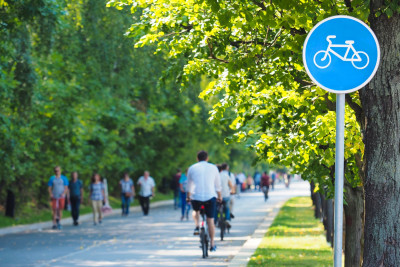Living sustainably is about reducing negative environmental and social impacts by making conscious and positive changes to your lifestyle. Its about using earth’s resources wisely and ensuring that future generations will be able to enjoy the same quality of life as us.
Are you looking to adopt a more sustainable lifestyle? Check out the sections below which provide some tips and guidance for how to achieve this.
Sustainable Transport & Travel
Transport is an essential part of everyone’s lives, it connects us to work, school, shops and services; enables us to take part in social and recreational activities; and moves people and goods to support businesses and industries. However, it is also a major source of greenhouse gases and other emissions, in particular from road and air travel, contributing to climate change and air pollution.
To reduce the negative environmental and social impacts associated with transport, Council is committed to an integrated land use and transport planning approach that enables more people to access their needs by walking, cycling, public transport and shorter car trips. This includes advocating for safer, integrated and inclusive public transport; creating an active transport network that is accessible, integrated, comfortable, attractive and safe for people of all ages and abilities; and promoting smarter, healthier, more environmental sustainable travel choices through education, promotion and communication.
Do you want to know more about how you can reduce your own transport and travel emissions? The sections below provide high-level information and links to further resources about how to adopt more sustainable transport and travel habits.
Active Transport
Did you know that changing just one of your regular car trips per day to active transport can reduce your carbon footprint by an average 0.5 tons of greenhouse gas emissions a year?[1] That is the same amount of greenhouse gas emissions emitted from driving approximately 2,000 km in an average low-efficiency Australian car[2].
Whether you enjoy walking, cycling, scooting, skateboarding, or using another form of active transport, there are many benefits to both you and the planet. Specifically, active transport is a great way to improve your health, reduce your environmental footprint, enhance social interactions, save money and support local businesses.
Wyndham has an extensive and expanding network of walking and bicycling paths to support your active transport habits. Visit Wyndham’s Bike Paths & Walking Trails webpage to explore areas around you. If you want to find out more about what Council is doing to support active transport, you can read the Wyndham Active Transport Strategy 2020.
Public Transport
Wyndham’s public transport network comprises of bus and train services, connecting you to destinations within and outside of the municipality. There are a range of individual and environmental benefits from using public transport, including cost savings from less expenditure on parking and fuel, safer and less stressful travel (e.g. you can read a book or listen to music while travelling) and less air pollution and greenhouse gas emissions than from car travel.
To explore Wyndham’s public transport network and plan your trip, visit Public Transport Victoria’s Journey Planner.
Carpooling, Carsharing and Low or Zero Emission Vehicles
While using active and public transport is preferential over car travel, some trips are not always viable by walking, cycling or taking the bus/train. There are couple of ways you can reduce your environmental footprint from car travels:
- When purchasing or renting a car, choose a greener model such as a battery-electric or hybrid vehicle – the Green Vehicle Guide compares the environmental performance of all vehicles on the Australian market. Sustainability Victoria also has a guide for buying electric cars for more information.
- Travelling to work, university or another regular destination? Explore the opportunity of carpooling with someone who might be doing the same journey
Holiday or Business Travel
Going further afield? There are a number of options available if you want to minimise environmental impact from your holiday or business travel, whilst getting social benefits.
- Travel consciously: air travel has a greater environmental footprint than any other form of transport. Avoiding air travel when possible and limiting the number of flights you take will significantly lower the carbon emissions associated with traveling. If your travel is for business, consider the need for the occasion to be in person and whether online conferencing can be used instead.
- Use public transport: if you are travelling to regional Victoria or interstate, there are many areas accessible by train or bus services which can also make the journey more comfortable and convenient. There may also be less time spent on commuting to airports and waiting for boarding, meaning travel via bus or train may be quicker than you think.
- Consider carpooling: if there are several people attending a meeting, conference or an event where public transport is not a viable transport mode, carpooling is another option to reduce individual emissions to and from the destination.
- Carbon offset your travel: when air travel is necessary and cannot be substituted for other transport forms, many airliners now offer the option of offsetting the carbon emissions associated with the flight. There are also tools available to help you understand the carbon footprint of your travel and identify options for offsetting, for example see Sustainable Travel International’s carbon footprint calculator.
[1] ScienceDaily. (2021). Ditching the car for walking or biking just one day a week cuts carbon footprint. Available at: https://www.sciencedaily.com/releases/2021/02/210208104624.htm
[2] Department of Industry, Science, Energy and Resources. Transport. Available at: https://www.energy.gov.au/households/transport
Sustainable Spending
Whether it is your banking, super, electricity, food or other essential items and services – where you invest and spend your money matters. The below categories provides guidance on how individuals can reduce environmental and social impacts from their spending in an effective and affordable way.
Investment & Banking
Many banks, superannuation funds and shareholder portfolios invest in projects which have negative environmental and/or social outcomes, such as fossil fuel developments or companies linked to modern slavery.
However, choosing a more ethical and environmentally conscious investment portfolio does not need to be difficult! There are guides available to assist you such as Market Forces fossil fuel comparison table or Responsible Investment Association Australasia Responsible Return tool kit.
Electricity
Want to make the switch to green energy today? Whether you are a renter, home owner or a business the Green Electricity Guide can help you make the change to renewable energy and ensure your electricity is not sourced from fossil fuels.
Want to learn more about how you can reduce the environmental footprint of your home or business while saving cost at the same time? Visit Wyndham’s Energy Smart Home and Energy Smart Business websites.
Shopping
Did you know that on average, every Australian dispose of approximately 23 kilograms of clothing to landfill each year?[1] Or that 88% of the 4 million computers and 3 million TV's purchased in Australia every year will end up in landfill?[2] Waste is major challenge in Australia with significant environmental consequences including the release of greenhouse gas from landfills and toxic chemicals polluting soil and waterways. Our high consumption of goods is also highly dependent on the continued use of scarce natural resources such as freshwater or minerals and require significant energy to produce. Want to know how you can minimise the negative environmental impacts of your shopping? See below for affordable and easy ways to change your shopping habits for the better.
Buying Consciously
The best way to reduce both your shopping costs and negative environmental and social impacts of products is to be conscious about what you buy and care for the items you have. For example, consider if something can be repaired before buying new and assess the need and use for the products you intend on purchasing.
For those looking to go further, there are plenty of resources available for how to embrace a minimalist lifestyle or create a capsule wardrobe to combat fast fashion.
Buying Second-Hand
If the item you need is essential, choosing pre-loved items first is a great way to reduce both the cost and the environmental and social impact of your products. Some of the benefits of buying second-hand items include:
- more affordable
- supports not-for-profit organisations and charitable foundations (e.g. where goods are sourced from charitable second-hand shops)
- reduces waste by extending the lifecycle of a product
- reduces the consumption of natural resources (e.g. water, natural fibres, energy, packaging)
- reduces pollution associated with the production and manufacturing of new clothes
Furthermore, the second-hand market is huge, and you can find anything from pre-loved clothes, furniture and electronics to bicycles and cars among much more.
A quick search on Google Maps is a great way to explore op-shops, second-hand stores / dealers near you. There are also several online platforms where individuals can sell their pre-loved items including Gum Tree and Facebook Marketplace. Do keep a look out in Wyndham's What's On Calendar as well for clothes swap events!
Buying Local
If you are unable to find what you need in the second-hand market, exploring local products has several individual, social and environmental advantages, specifically it can:
- support the local businesses in your area and stimulate the local economy
- lower the cost of products as transport costs are reduced
- reduce the carbon footprint of the product from less transportation needs
- foster connections amongst the community
Being a municipality with agricultural, small business, large-scale commercial and manufacturing capabilities, there are a variety of goods and products produced in Wyndham.
Are you a keen home grower of veggies and other produce? Consider visiting a Food Swap where you can meet like-minded people and exchange your produce. To find a Food Swap event near you, visit the Community Garden & Food Swaps webpage.
Where products are not available in your local area, consider products produced in Victoria or Australia prior to looking at international markets.
Buying Ethical and Sustainable
In addition to buying local, other things to consider when purchasing new goods is the social and environmental impacts associated with that particular product. There are several ways you can identify and assess this, including:
- Look for product and businesses which are certified for social and/or environmental purposes (e.g. Forest Stewardship Council wood products, B-Corp certifications for businesses, Good Environmental Choice Australia). To learn more, you can explore current international and Australian certifications on websites such as Ecolabel Index.
- Read up on the company you are buying from, many companies now have sustainability statements on their websites.
- Check what the product is made from, e.g. with preference for natural or recycled products
- Use websites such as Good On You to discover ethical brands


